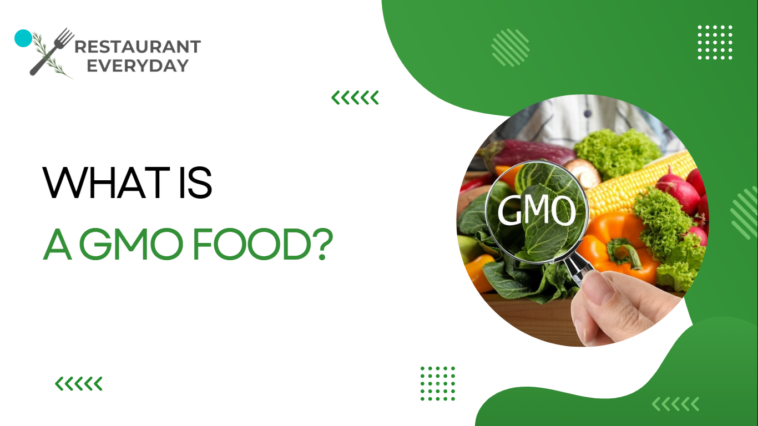GMO stands for Genetically Modified Organisms have become an integral part of the global agricultural landscape, representing a scientific breakthrough in the alteration of living organisms at the genetic level. At its core, GMO technology involves manipulating the genetic material of plants and crops to enhance desirable traits. To comprehend the significance of GMOs, it is crucial to delve into their definition, explore the historical evolution of GMO technology, and acknowledge their pivotal role in addressing challenges within the agricultural sector amidst the rising halts of food wastage.
What is GMO Food and How is it Created?
Genetically Modified Organisms (GMOs) refer to living organisms, particularly crops or animals, whose genetic material has been altered through genetic engineering techniques. This alteration is aimed at introducing specific traits or characteristics not naturally present in the organism.
The creation of GMO food involves precise and controlled manipulation of an organism’s genetic material. The two primary techniques used in genetic modification are recombinant DNA technology and CRISPR-Cas9 technology.
Recombinant DNA Technology
- Isolation of Genes: Scientists identify and isolate genes with desired traits from one organism.
- Insertion into Host Organism: The isolated genes are then inserted into the DNA of the target organism, typically a plant or crop.
- Expression of Traits: The modified organism, now carrying the introduced genes, expresses the desired traits, such as resistance to pests, tolerance to herbicides, or improved nutritional content.
CRISPR-Cas9 Technology
- Selection of Target Genes: CRISPR-Cas9 allows for precise gene editing by targeting specific genes within an organism’s DNA.
- Introduction of Genetic Changes: The Cas9 enzyme is used to cut the DNA at the desired location. When the cell repairs itself, it may incorporate new genetic material, resulting in the expression of modified traits.
- Precision in Modification: CRISPR-Cas9 is known for its high precision, enabling scientists to edit genes with greater accuracy compared to traditional methods.
Types of GMO Foods
Here are some common types of GMO foods that are commonly found in our dietary items.
- Soybeans:Engineered for herbicide resistance and improved yield.
- Corn (Maize):Modified for pest resistance, herbicide tolerance, and improved nutritional content.
- Cotton:Genetically modified for insect resistance and improved fiber quality.
- Canola:Engineered for resistance to pests and tolerance to herbicides.
- Sugar Beets:Modified for resistance to certain herbicides.
- Papaya:Some varieties of papaya have been genetically modified for resistance to the ringspot virus.
- Alfalfa: Engineered for herbicide tolerance.
- Apples: Genetically modified to resist browning.
- Potatoes: Some varieties are modified for reduced bruising and lower levels of acrylamide.
- Salmon: AquAdvantage salmon is genetically modified for faster growth.
- Tomatoes: Modified for improved shelf life and resistance to certain diseases.
- Rice: Golden Rice is engineered to produce beta-carotene, a precursor to vitamin A.
Pros of GMO Food
Genetically Modified Organisms (GMOs) in food production have been the subject of extensive research and development, offering various potential benefits. Here are some of the pros associated with GMO foods:
Increased Crop Yields
One of the primary advantages of GMOs is their potential to significantly increase crop yields. Genetic modifications can enhance the efficiency of photosynthesis, nutrient utilization, and overall plant productivity. This can contribute to addressing food shortages and meeting the demands of a growing global population.
Enhanced Nutritional Content
Genetic engineering allows for the enrichment of crops with specific vitamins, minerals, or other nutritional elements. This can lead to the development of biofortified or bioengineered crops that offer improved nutritional profiles, helping combat malnutrition and dietary deficiencies in certain regions.
Resistance to Pests and Diseases
GMOs are often designed to express traits that make them resistant to pests and diseases. This can reduce the need for chemical pesticides, decreasing the environmental impact associated with traditional pest control methods and minimizing potential harm to non-target organisms.
Improved Tolerance to Environmental Conditions
Genetically modified crops can be engineered to withstand challenging environmental conditions such as drought, salinity, or extreme temperatures. This trait contributes to the development of more resilient crops capable of thriving in diverse climates.
Reduced Need for Chemical Pesticides
By incorporating resistance traits, GMOs can reduce farmers’ reliance on chemical pesticides. This not only minimizes environmental contamination but also has potential health benefits for agricultural workers and nearby communities.
Faster Development of Desired Traits
Traditional crop breeding methods can be time-consuming. Genetic modification allows for the targeted introduction of specific traits without the need for lengthy breeding cycles, potentially accelerating the development of crops with desired characteristics.
Economic Benefits for Farmers
Some genetically modified crops are engineered to provide economic benefits to farmers, such as increased yields or reduced inputs. This can improve the economic viability of farming operations, especially in regions facing challenges like unpredictable weather conditions.
Extended Shelf Life
Genetic modifications can be applied to enhance the shelf life of certain crops. This can reduce food waste by preventing spoilage during transportation and storage as in restaurant leftovers, contributing to more sustainable food systems.
Bioremediation Potential
GMOs have the potential to assist in environmental cleanup through a process known as bioremediation. Certain genetically modified organisms can be designed to absorb and detoxify pollutants in soil or water, offering a potential solution for environmental contamination.
Cons of GMO Food
The debate surrounding Genetically Modified Organisms (GMOs) in food production also includes various concerns and criticisms. Here are some of the cons associated with GMO foods:
Environmental Impact
Critics argue that GMOs may have unintended consequences on the environment. This includes the potential harm to non-target organisms, such as beneficial insects, and the disruption of ecosystems due to the cultivation of genetically modified crops.
Cross-Breeding with Wild Plants
There is a concern that genetically modified crops may crossbreed with wild plants, potentially creating hybrid plants with unpredictable traits. This could lead to unintended environmental consequences, including the spread of genetically modified traits to non-agricultural areas.
Health Risks and Allergenicity
There are concerns about the potential health risks associated with consuming GMO foods. Critics worry that the introduction of new genes into crops could lead to allergenic reactions in sensitive individuals, as the allergenic properties of certain transferred proteins may not be fully understood.
Antibiotic Resistance Genes
Some GMOs are created using antibiotic resistance genes as markers during the genetic modification process. Critics argue that this practice may contribute to the development of antibiotic-resistant bacteria, posing a potential risk to human health.
Corporate Control and Patents
The concentration of GMO technology in the hands of a few biotechnology companies has raised concerns about corporate control over the food supply. The patenting of genetically modified organisms allows companies to exercise control over the use, distribution, and pricing of certain crops.
Ethical Considerations
The ethical implications of genetic modification are a subject of debate. Some argue that altering the genetic makeup of organisms raises moral questions about “playing” with nature and the potential unforeseen consequences of manipulating genes.
Consumer Choice and Labeling
Many consumers advocate for the right to know whether the products they purchase contain GMO ingredients. The lack of mandatory labeling in some regions raises concerns about transparency and the ability of consumers to make informed choices about the food they consume.
Potential for Unintended Consequences
The complexity of genetic interactions within ecosystems raises concerns about potential unintended consequences of releasing genetically modified organisms into the environment. The long-term effects on biodiversity and ecosystem dynamics remain uncertain.
Are GMO Foods Safe?
The safety of genetically modified organisms (GMOs) and their associated foods has been extensively studied, with the scientific consensus strongly supporting their safety for human consumption. Leading global health organizations, including the World Health Organization (WHO) and the National Academy of Sciences (NAS), have conducted comprehensive reviews affirming that approved GMOs are not likely to pose risks to human health.
The European Food Safety Authority (EFSA) and various national health bodies share this perspective, endorsing the safety of genetically modified crops for cultivation and consumption. The American Medical Association (AMA) and the Royal Society of Medicine (RSM) also emphasize that the available evidence does not justify concerns about the safety of GMO foods. Ongoing regulatory oversight and continuous research contribute to ensuring the safety of GMOs, and it remains crucial to consult reputable scientific sources for the latest information on this topic.
Are GMO Foods regulated by USA?
Yes, genetically modified organisms (GMOs) and their foods are regulated in the United States. The regulatory framework involves three federal agencies: the U.S. Department of Agriculture (USDA) oversees the approval and release of GMO crops, the Food and Drug Administration (FDA) assesses the safety of GMO foods for human consumption, and the Environmental Protection Agency (EPA) regulates GMOs with pesticide-related traits. This coordinated framework ensures rigorous evaluations before GMOs are approved.
How to find Non-GMO foods?
- Look for products with “Non-GMO Project Verified” seal or other Non-GMO certifications.
- Read ingredient lists; avoid products with common GMO ingredients like soy, corn, canola, and sugar beets.
- Choose USDA Organic-labeled products, as organic standards prohibit GMOs.
- Opt for products from brands explicitly committed to Non-GMO practices.
- Shop at farmers’ markets for locally sourced, potentially Non-GMO produce.
- Avoid high-risk ingredients such as corn, soy, canola, cottonseed, and sugar beets.
- Use Non-GMO apps/resources like the Non-GMO Project website or “Buycott.”
- Educate yourself on GMO regulations in different countries and consider the country of origin.
- Advocate for clearer GMO labeling to support informed consumer choices.
Conclusion: Benefits and Concerns of GMO Food
In conclusion, the intricate world of GMOs is a dynamic blend of innovation, benefits, and concerns. The role of GMOs in addressing global food challenges is undeniable, with their potential to enhance crop traits and increase agricultural productivity with increased shelf life of most of the TCS foods with genetic engineering. As we navigate the future, the importance of continued research, ethical considerations, and responsible use of GMO technology cannot be overstated. The balanced integration of GMO foods into our agricultural practices demands ongoing scrutiny, transparency, and a commitment to sustainability for the benefit of both current and future generations.
People may also like to read: What is the Healthiest Fast Food Restaurant?




